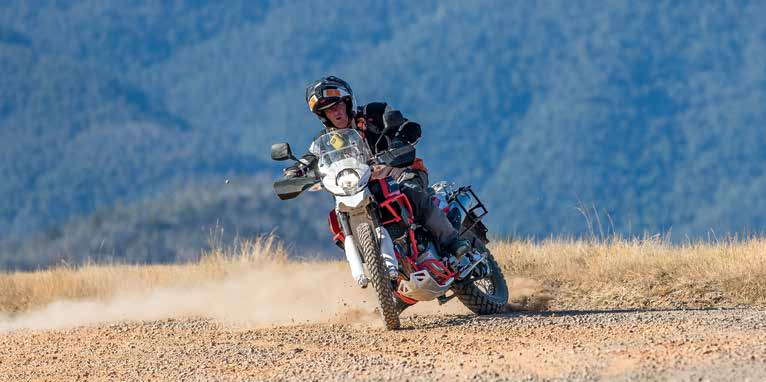- It’s what we do
- Bucket Haul
- Husqvarna 901 Norden
- Journey To The Top
- Geoff Ballard’s BMW R1200GSA
- Nowra Three-day
- Maidenwell
- Death Or Glory
- Age Shall Not Weary Them
- Rocky Mountain High Ride
- Alice Springs And Back
- Shop Bike 02
- Really? with Greg Yager
- Shop Around with Karen Ramsay
- Led Me Astray with Andy Strapz
- Held Mojave Jacket
- Fit Out
- Checkout
Cross training, training for riding that doesn’t involve actually riding a bike, is a good idea.
Any exercise which increases endurance and strength is beneficial and will promote better riding performance.
For adventure riders – who tend to be a little older – flexibility training like yoga or pilates can reap huge benefits.
But there’s no substitute for time on the bike.
If you want to be good at crossing logs, get on your bike and cross a lot
of logs. If you need to be able to cover long distances, start riding early in the morning and don’t stop until you’re exhausted. And as soon as you recover, get back on the bike and do it again.
Keep doing it. Eventually you’ll build up the endurance to survive the long days and big distances.
No amount of cross training will substitute for actually honing the specific skills and techniques of riding a motorcycle.
There’s also a narrower view of cross training which advocates practicing on a trials or enduro bike, and it’s an excellent way to improve rudimental skills. I’m a big fan of this philosophy because riders have a better chance of mastering a skill or technique on a light bike which is forgiving of an accidentally tweaked throttle or locked wheel than they do on a two-wheel mine truck with 160hp which “ No amount of cross training will substitute for actually honing the specific skills and techniques of riding a motorcycle. ” threatens to tear their arms off or crush them for a split second of inattention.

But still, ultimately, the small-bike training has to be transferred to the rider’s regular bike, and I feel lately that’s a step a lot of riders are avoiding.There’s no doubt you’ll be a better rider if you spend time on a 70kg, 30hp, two-stroke with light-ning-fast geometry practicing late braking and negotiating ruts, but it’s going to be a hell of shock to the system when you try those manouevres on a fully laden 200kg behemoth.
And that’s the point I’m trying to make.
Make sure you do move those techniques across to your adventure bike as part of your training. Don’t get it all right in the paddock at home on the dirtbike and think it’ll all be okay when the shit hits the fan on the next ‘real’ ride.
It won’t be.
There’s no substitute for time on the bike, and there’s no substitute for time on your own bike. Load it up as you would for a normal ride, then head out into the paddock and tackle those same witch’s hats, mud wallows and brake slides you were getting so good at on the small bike. It’ll be tough, but it’s what you’ve been working for on the smaller bike, and the time to make the transition is at your home training ground where you can control the pace and the terrain.
Cross training is good, and we should all be doing whatever exercise we can.
But we need to learn to handle our adventure bikes, and there’s only one way to do it. It’s not watching YouTube videos or spending time at the gym.
It’s riding and challenging ourselves under controlled conditions.


















Comments